#bheem 2022
Text

Get in loser we're kicking out the British Raj
#rrr#rrr movie#this movie rocks and you should watch it several times over and over again#rrr 2022#komaram bheem#alluri sitarama raju#raju#bheem rrr#ram x bheem#rrr fanart#rrr film#tollywood#movies#indian films#doodles#doodle#doodle dump#digital art#sketchbook#sketch#drawing#art#artists on tumblr
127 notes
·
View notes
Text

okay but this scene makes me laugh because can you imagine hanging out with your boyfriend and he just goes, “i have something to show you.”
#rrr movie#rrr 2022#komuram bheem#alluri sitarama raju#rambheem#bheem looks so proud of himself too like???
77 notes
·
View notes
Text

RRR fanart by me
#rrr bheem#jr ntr rrr#rrr film#rrr movie#rrr fanart#rrr#rrr 2022#bheem rrr#jrntr#ntr jr#tollywood fanart#pinkpersonsblog#pinkperson
25 notes
·
View notes
Text


I wanted to hurt you
but the victory is that I could not stomach it.
#rambheem#rrr#rrr 2022#alluri sitarama raju#komuram bheem#ram charan#jr ntr#richard siken#croissant rambles
202 notes
·
View notes
Text

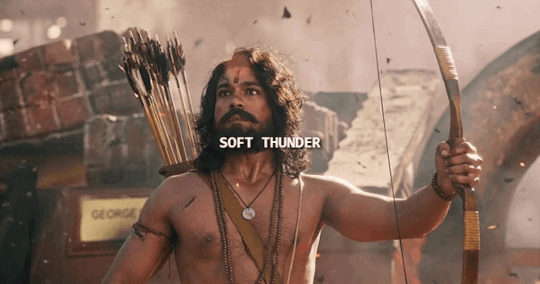

Special shoutout to @fangirlshrewt97 for suggesting the idea! (insp.)
@rambheemlove, @dumdaradumdaradum, @lil-stark, @budugu, @burningsheepcrown, @iam-siriuslysher-lokid, @stanleykubricks, @ssabriel, @ronnoxandlumoss, @bitchy-bi-trash, @ramcharantitties, @voidsteffy, @nyotamalfoy, @thewinchestergirl1208, @jrntrtitties, @ronaldofandom, @yashuika, @lite-teesko, @stuckyandlarrystuff
»»»— read pinned post for taglist info —«««
»— Masterlists links in bio —«
#rrr#rrr 2022#rrr movie#rrr gifs#jr ntr#ramcharan#rrr jt ntr#rrr ramcharan#rambheem#rambheem gifs#ramaraju x bheem#ramaraju x bheem gifs#rrr bheem#rrr ramaraju#jr ntr as bheem#ramcharan as ramaraju#my gifs#milla gifs rrr#favorite ship dynamic
598 notes
·
View notes
Text
the tiger

he destroyed his cage

yes

YES

the tiger is out
(his name is Bheem and he is going to fuck you up)
109 notes
·
View notes
Text
@astrafangs @boochhaan @vijayasena @veteran-fanperson @velchix @fathomlessbabbling @fangirlshrewt97 @fadedscarlets @mishackles89 @minusculetony @milla984 @stanleykubricks @stuckyandlarrystuff @gifseafins @gayathreya @iam-siriuslysher-lokid @justmeand-myinsight @jrntrtitties @jjwolfesworld @kokoreram @kookiries @kajaaaaaaal @kaanangulzaar @kaagazkefool @obsessedtoafault @eremin0109 @ririsasy @rrr2prayercircle @rambheemlove @ramcharantitties @rapunzels-stuff @rambheem-is-real @rosayounan @ronaldofandom @ronnoxandlumoss @rambheemisgoated @panko-tattoo @ladydarkey @carminavulcana @your-villainous-neighbour @yehsahihai @matka-kulfi @talesofthetigerrr @stars-in-the-distance @teddybat24 @hufhkbgg @hachinana87
#rrr fanfic#jr ntr#rambheem#rrr fandom#alluri sitarama raju#komuram bheem#ram x bheem#rrr fanart#rrr film#rrr movie#bheem rrr#ram x reader#rrr 2022#rrr chhello show oscars#tigerrr2023#bheem x reader#bheemram#ram charan#rrr tarak charan#tarak#charak#trending#source: tumblr#newpost#top post#jenny rrr#rrr#rrr naatu naatu#rrr dosti#dosti
99 notes
·
View notes
Note
how people can love ram ? after whatever he had done with bheem ?
My love even bheem loves him after all that, you know why? Because he didn't have a choice, he had a bigger purpose, a promise that he had to keep, to bring a better tomorrow for his people, to live like actual human beings instead of being lapdogs for the british
It hurt him a great deal to do that to his friend but he had to do it, it's what bheem would've wanted no?
So yes he caused harm but only to bring back peace for his people
How could we not love him after all he has done, sacrifices he has made just to fulfill that promise he made
43 notes
·
View notes
Text

gonna fight them frrr, how dare they make me so obsessed!
(ID: An ensemble sketch page of Rambheem ship from RRR: Rise Roar Revolt, with the main leads Alluri Sitarama Raju and Komuram Bheem engaged in various boypal things. They're kissing up there on the left, and right under that Ram is faceplanting betwixt Bheem's lusciously furry chest as a response to the latter fondly asking if he's had a "long day, na bangaaru?" There's also a lil doodle of Ram getting his ass Devoured by Bheem but the artist has put a huge vermillion splotch over that so don't worry tymbleeeee I'm not breaking your stupid rules haha 🙄
The right side of the page consists of two narratives: one with Bheem getting ready to swing down a vine and he's dressed in Gondi-casual aka only loincloth cuz it's blippin hot in the forest. Ram, accompanying him with bow and arrow, is trying to stare respectfully and failing - Bheem is cheerfully oblivious as he chatters about something. The other storyline is Bheem's turn to be gobsmacked heartwhacked brainwhipped... he's just going on about his business when Ram appears in front of him, with an anecdote about Malli guinea-pigging him for braiding practice, wearing the results with Flowers. Bheem is sweating and Ram is amused.
The rest of the space is used for face studies and little chibi of the two, with the tag: Ram Loves Bheem! Bheem Loves Ram! Rambheem Love... REVOLUTION!! Cuz they are freedom fighters, fanfic version notwithstanding ;)) End ID)
#rambheem#rambheem rrr#alluri sitarama raju#komuram bheem#rrr fanart#my art#AUGH! THEY!!!!!!#rrr 2022#dm me for twt link I guess#tho the asseat doodle is honestly nothing to write home about. i'll draw proper smut of them later and Not upload it here </3)
94 notes
·
View notes
Text
On Bheem acting as a "mediator" between Ram and Seetha
[Disclaimer: this is not about shipping wars, it's just an analysis because I find the dynamic interesting. Whether you ship rambheem or ramseetha or both or neither is irrelevant for this, and beside the point.]
Click here to read this post on Ao3
It always drew my attention that most of Ram and Seetha's interactions seem to be mediated by Bheem. That is, have him as a middle man; there is the obvious part where Bheem brings Ram back to Seetha, but it's more than that. Ram also only writes to Seetha because of Bheem. When they first reunite, it is Bheem who joins their hands together. Even during Etthara Jenda, there is no moment with just Ram and Seetha; Bheem is always there. In fact, there is a brief moment with only Bheem and Seetha, but none with only Ram and Seetha. It seems that Ram and Seetha only ever meet through Bheem, as if he's the thread connecting them.
I thought that was interesting and I think I'd like to expand a bit on that. At first I thought it was just because the movie is obviously focused on Bheem and Ram and their relationship and the other characters are... Just not that explored outside of their relationship to the core characters and/or the plot. But I think there is also some symbolism there that is worth exploring.
When Ram leaves Seetha, he tells her that a part of him will always be with her. I'm working with the English translation here, because unfortunately I don't speak Telugu, but I did check the Portuguese, Spanish, and Italian translations and they all pretty much translate the same, so I'm going to assume that the translation here is accurate and communicates everything it's supposed to communicate. That means that leaving Seetha is also leaving that part of him behind. I mean, the symbolism is pretty obvious here. He takes his pendant, which was a single circle, and breaks it in two. One part he takes with him, another he leaves with her. From that moment on, Ram is incomplete.
And I think that the part that he left with her isn't just, generically speaking, half of him; I think the part that he left with her was his own humanity.
Here's why.
When Ram leaves his village, he takes two things with him: his grief and his sense of duty. That is all he has in Delhi. Well, other than his uncle, but his uncle was already in Delhi before Ram went on his mission, so I don't think he counts as something Ram "takes with him". I really doubt Ram would have asked Venkateswarulu to come if he hadn't already been in the police force before Ram was.
When we first meet Ram, the only emotion he allows himself is anger, and even then, only in private where no one can hear him. Even Venkateswarulu seems unable to really reach him. Ram is fueled exclusively by his rage, his need to do something to alleviate his grief, and his promise. He has no meaningful connections with anyone, he doesn't allow himself his feelings, and he needs to keep everything that makes him himself locked away so he doesn't blow his cover. Ram is living in nearly complete isolation and completely detached from his own feelings; he doesn't even allow himself his grief, because it would get in the way of his mission. It serves as fuel and a reminder of what he has to do, but it's not something he is actually allowing himself to feel in full.
So what is missing? He is missing his sense of community. His history, because Seetha has been a part of his life since forever, and she is also the embodiment of his connection to his village as a whole. His love and his joy, because everything that was meaningful and dear to him he left behind with her. And as time goes by... More and more, he leaves his ideals, too. By the time we meet Ram, he isn't really fueled by his need to free the land; he is fueled by his grief. When he falters, he doesn't think of the free world him and his father envisioned; he thinks of the despair he felt as he watched him die. He is doing this because he is, in a way, trying to provide meaning to his family's death, trying to save them symbolically, trying to alleviate his survivor's guilt and fulfill his promise. He gets so fixated on the weapons he forgets they're a mean and not an end. Therefore, his beliefs ended up staying with Seetha as well.
So... Community, history, love, and beliefs. Combined, I'd say that's pretty much everything that makes us human. Of course, pain is part of the human experience as well, but without those... There isn't much else left for a person.
And look, I'm not saying that Seetha makes him good or that she exists to take care of him and bring him back to himself, I want to make that clear. This isn't about anything in particular Seetha does or should do to or for him; this is about the fact that Seetha was the last good thing Ram allowed himself, and therefore his distance from her is also his distance from his own needs. The further he is from Seetha, the further he is from himself and his humanity.
I think there are at least two scenes that add credibility to that thesis: the first and most obvious one is when he is torturing Lacchu and his wristband snaps. When Ram first gets to the point of no return, when he is doing the most inhuman thing you could conceive, and he's doing it with gusto, too, because he's angry, he completely loses his connection to her. And then it immediately cuts to Seetha not only waiting for Ram, but actively asking a kid to scout and check if he is there. She is unable to find him, unable to connect again; and then it is made pretty clear that Ram has strayed too far from her. It is immediately after that moment that we learn he hasn't written to her in all these years, and one of the villagers even asks her if Ram remembers her at all. I also think it's interesting that it's the rest of the village that voices the concern for Ram and the sense of betrayal, and not Seetha; not to mention that they went to her to ask what is happening with Ram. This further cements Seetha as a representation of his connection to his own past and people: it is through her that they seek him out, and therefore, she is the link between them.
(Again, I'm not saying that she is literally the one doing the work of keeping them together; I'm saying that the movie has her, symbolically, embody the entire village. So when we are reminded of his distance from her, we are also reminded of his distance from them, and therefore, from himself)
The second scene is when he, finally, after all these years, writes to her. This is the first time in the movie where Ram actually voices his thoughts, instead of just screaming and drowning in his own memories. We know what Ram is feeling and thinking, but he never allows himself to acknowledge it. When he does, he does it through talking to Seetha; because she is the one who keeps the part of him that allows himself to feel, the part that is idealistic and that is doing this for love for the motherland rather than hatred for the British. The part that remembers what he is really fighting for.
And not only does he seek himself in Seetha, he is also only able to connect to Seetha when he stops denying himself. I actually think that's the most important part. He has spent four years isolated from her, without any sort of communication; he lost his way to her because he locked out his own humanity to be able to survive being a double agent. It is only when he unlocks it, really allows himself to feel and think and question, that he is able to find his way back to her.
And what allows him to unlock his humanity and search for her in the first place?
Bheem.
That's where his mediation comes in.
Because Bheem was the first one to crack Ram's walls at the very least since he went to Delhi, but I'd risk saying that really it's the first time since he lost his family. He kept everyone at arm's length; he threw himself into his mission as a way to avoid actually processing his grief. Of course he still had his village and Seetha, but you don't just become this repressed and guilt driven out of nowhere. Even as he's saying goodbye to Seetha and the village, Ram doesn't once smile. We see his face tight and nearly blank, the same way it was when he was first introduced, fighting that mob. There is determination, but otherwise, he is completely closed off. And he is leaving alone.
And then he meets Akhtar, and this motherfucker becomes unrecognizable.
I've joked before that he must have pulled his cheek muscles after he met Akhtar, but it is seriously a jarring difference. He spends the entire Dosti montage grinning from ear to ear, save for the "don't eat with your left hand" moment and the parts where they aren't actually together. We have never seen him give even a tight lipped smile before, and suddenly the man can't stop laughing. We have never seen him express a clear emotion, and suddenly we have him not only emoting but also showing vulnerability. Even after the montage, Ram is frequently grinning at Bheem, and he is shown with his body language relaxed when we've only really ever seen him tense. In fact, not only tense, but so tense he is frequently shaking.
It's not even just the expression of positive emotions. Meeting Akhtar also gives us our first glimpse of who Ram truly is and what he actually believes. The best example of that is the events in Naatu Naatu. For the first time ever, Ram rises up against the British. Even if it's in a small way, it's an act of open defiance that we hadn't seen before. He taunts Jake, he mocks him, he openly laughs at him (which is also curious, considering that Bheem was the one that Jake hurt; but Bheem is largely ignoring Jake, while Ram is going out of his way to antagonize him). The part of Ram that is purely rational and mission driven would have thought it better not to draw attention; so when Ram chooses to take that risk and be defiant, he is also remembering what really matters to him: protecting his people and fighting for justice. And that takes the form of protecting Bheem.
Therefore, those parts of him that had been kept away suddenly come crashing back when he meets Bheem. Bheem helps him find his way back to himself without even trying, and if he is finding the way to himself, he is finding the way to Seetha. Not to mention that it is because of the fact that he couldn't live with betraying Bheem that he wrote to Seetha in the first place. Bheem helped him find the part of him that loves and rejoices and is driven by more than just rage again. So, when he turns his back on Bheem, he is also going back to denying himself his own humanity. But he can't actually do it this time; and so, when he finds himself unable to keep repressing himelf, he writes to Seetha.
Even before that, however, Ram's connection to Seetha is only shown to the audience through Bheem, and the link between his relationship with Bheem and his relationship with Seetha is shown from the very first time we learn about her.
We are first shown the pendant during the Dosti montage. Ram was wearing it before, of course, but the movie kind of went out of its way to hide it. In his introduction, he is straight up not wearing it. The first time he is shown with it is when he is destroying that poor punching bag, and he nearly immediately wraps his hands and wrist in tape that covers it:

[ID: Screencap of Ram punching the bag, where you can see his knuckles and wrist are wrapped in tape. End ID]
Then, in the "RRR" title page, they didn't include Ram's pendant in the drawing of their hands together, even though they kept Akhtar's wristband:


[ID: Screencaps of Ram and Bheem's joined hands when they meet; you can see that Ram is wearing his wristband. Then, when it transitions into the drawing, his wristband is no longer shown, but Bheem's is. End ID]
They're not always hiding it, and you can frequently see it on Ram's wrist if you know to look, but they don't draw attention to it and actively avoid accidentally drawing attention to it.
(But also, interestingly enough, it is first visible in the scene where Ram is talking to Venkateswarulu; and the scenes where it is most visible before Dosti are the ones where Ram is talking about killing governor Scott, and when he's helping Bheem save the child. I think this is a subtle way of hinting that this is who Ram truly is; even though he is pretending when he says that he's going to kill governor Scott, he is still closer to himself and his ideals than he was when he attacked that mob. And even more so when he helped Bheem do what they both are sworn to do: protect their people.)
Then, during the Dosti montage, they film it directly for the first time. We see Ram playing with it and acknowledging it, and we learn that it is significant to him. And then they won't stop filming it after that.
This isn't a coincidence; the pendant is the embodiment of his connection with Seetha, and, therefore, with his humanity, as previously stated. The fact that it is shown during Dosti, which is also when we first see Ram acting fully like himself, goes to show how much Bheem's friendship is helping bring Ram back. I mean, for starters, just sitting there fiddling with it and smiling is something I can't imagine pre-Bheem Ram doing. Nevermind the fact that he lets Bheem see it and doesn't even try to hide that moment of vulnerability from him.
After that, the pendant is used to highlight Ram's struggle with figuring out what he wants to do (which really means figuring out who he is) after he betrays Bheem. For example, when Ram grabs Bheem, we get a shot of him crying blood, and the blood falls right beside the pendant, in a shot that shows almost nothing but these two things:

[ID: A drop of blood falling on Ram's hand, right next to the pendant. You can seee only Ram's wrist and a bit of the holy thread wrapped around his palm. End ID]
(Also, this time, the illustration of their hands does include the pendant)

[ID: The illustration of Ram's hand that immediately follows the previous shot. The pendant can be seen wrapped around his wrist and over his palm. End ID]
Further cementing the idea that the wristband represents the last of his connection to his humanity is the fact that, in the flogging scene, Ram is wearing it on his left hand.
In every other scene, it is on his right hand. That seems to be something they were very careful about. But throughout the flogging you can see that it is on the left. In fact, they even open the scene with a shot of it:
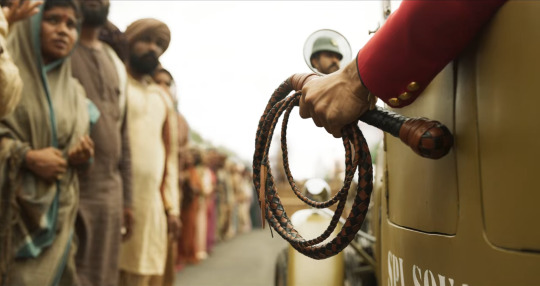
[ID: Ram driving to the square. He is holding a whip in his left hand, and the bracelet can be seen on his wrist. End ID]
Throughout the scene, it is hard to see the bracelet because of the uniform's long sleeves, but there are a few shots that confirm that it's on his left wrist:

[ID: Ram with the whip on his right hand, pulling it back. His left hand is in front of his body and the bracelet is visible. End ID]
And at the end of the scene, we can see it clearly:

[ID: Ram cradling Bheem's bloody face. His left hand, on which you can see the pendant, is holding Bheem's chin. End ID]
It's too consistent to be an accident, especially considering how it never ends up misplaced in the left wrist in the other scenes. On top of that, the movie brings up the fact that the left hand is considered dirty (in the scenes where Bheem's fake mom and Ram's real mom tell their respective children not to eat with their left hand).
Disclaimer for this part: I'm neither Hindu nor Indian, so I looked up as much as I could on the right/left significance, because I believe people should make an effort to understand the implications that don't speak directly to their experiences, especially when it comes to culture and race. If anything I say is inaccurate or offensive, please let me know, and I'll edit it. If there's anything else I'm missing, feel free to add it as well. I also assume that the cultural associations with the right and left go beyond religious significance, since Akhtar's family is Muslim and not Hindu and they also enforce the "no eating with your left hand" rule. But Ram is Hindu, so I'm also using sources that talk about its significance in Hinduism. I don't mean to imply that the two are interchangeable by that.
I found many different significances associated with the right and left sides in Hinduism (right is male, left is female; right is submissive, left is contrary; right is yourself, left is your spouse), but the most important one seems to be that right is sacred and pure, and left is profane and dirty (because that one was mentioned in every paper I found, and it was usually the first to be brought up). Hence why it's important that you eat and give offerings with your right hand, and do "unhygienic" tasks with the left. This rule also applies to Islam, which explains why Akhtar's fake mother made the same comment. The fact that this aspect of the right/left duality is brought up in the text also implies that this is the most important one in this context.
So, if the left hand is dirty and profane, and the pendant is Ram's humanity, and the pendant is on Ram's left hand in this scene... I think what the movie is telling us is that in this moment, Ram is forsaking himself. He is going against everything that he truly is and believes, and his own feelings; he is even condemning himself, in a way, because this is the kind of thing that there should be no turning back from. In that moment he is the furthest he could be from everything that is holy, and good.
(Also, from a Watsonian perspective, we know that Ram has been taught that the left hand is dirty by his mom; if he chose to change the placement of the pendament in that moment, I think that speaks volumes on how he's feeling about himself. I also think it's possible that he did it because he couldn't stand to whip Bheem with the same hand that held his reminder of Seetha).
I also find the "right hand is yourself and left hand is your spouse" significance relevant here, although secondarily. I know Ram and Seetha are not married yet, so I'm not sure if Ram's left hand already "counts" as representing Seetha, but even if it doesn't, I think the fact that Ram is putting the embodiment of himself away from the hand that represents himself and on the wrist that is supposed to (at least eventually) represent Seetha goes to show that he truly left everything that matters about himself with her. His soul is no longer resting within himself because he turned his back on it. So, it is all with Seetha. If he had left half of his true self with her before, once he whips Bheem, he fully abandons himself. All that's left of the true him is in Seetha's memories.
This is, I think, further enforced by the fact that, although we get enough shots of Ram's left wrist to confirm that it's there, what the movie focuses on the most during that scene is not its presence on the left wrist, but its absence on the right one. Ram's right sleeve is always slightly pulled up in that scene, so we can see that the wristband is not there, like the movie is constantly calling to our attention that something is wrong with Ram. On the same vein, during Komaram Bheemudo, the framing very carefully hides his pendant in most shots. They go out of their way to leave it out of frame, even in the closeup shot of Ram wiping his tear (which he does with his left hand, where the wristband is at the time).
Here are some examples of both the framing and the sleeve being ridden up:

[ID: Ram picking up the spiked whip. The shot cuts right where his left wrist would begin, but shows most of his right arm. The sleeve is ridden up til nearly mid-arm, so you can clearly see that he's not wearing the wristband. End ID]

[ID: Ram first hitting Bheem with the spiked whip. His sleeve is still rolled up, and his wrist is in the foreground, without the wristband. His left hand is behind his body, out of frame. End ID]
The entire Komaram Bheemudo scene focuses on the lack of the wristband, aka the lack of Ram's own self in that moment. He is doing everything he is supposed to be fighting against, and betraying himself in the process. So the absence of him is felt even more acutely than the displacement itself.
Then, when Ram decides that he is going to save Bheem, the opposite happens: they go out of their way to keep the wristband within the frame. Even when Ram first shows up in that scene, it is framed in such a way that the part of him closest to the viewer is his right wrist.
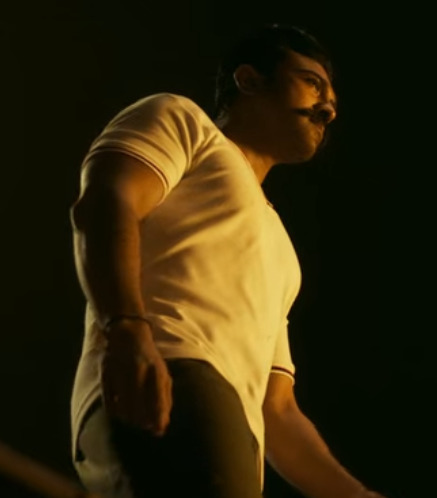
[ID: Ram walking into the scene where Bheem was flogged. It is shot from under him and to his right, so his right wrist is the thing closest to the camera. You can see the wristband on it. End ID]
Even when he is being filmed from the left, the wristband is still visible:

[ID: Ram being filmed from the left side as he talks to his uncle. He is shown from a 3/4 position, so we can see the wristband on his right wrist even as it is turned away from the camera. End ID]
And even when there are other objects obstructing part of him, the framing is such that you can always see it:
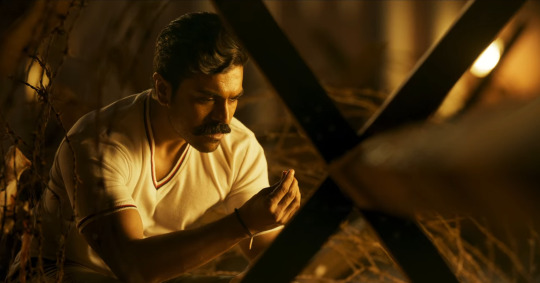
[ID: Ram looking at the blood on his hand. He is shown from within a circle of barbed wire. There is an X right beside him, but it is still framed in such a way that Ram's pendant is visible as he raises his hand to look at it. End ID]
In fact, during that scene, we get a closeup of the pendant for the first time since Ram betrayed Bheem:

[ID: Ram touching the ground, which is wet with Bheem's blood. The pendant, back on his right hand, is visible on his wrist, resting over his palm. End ID]
And the trend continues: you don't see his wristband at any point while he is talking to Governor Scott, but you do see it many times when he is rigging the weapons to save Bheem (complete with several closeups, but they are very quick). Very interestingly, when he puts Malli in the car and drives towards the hanging point, the framing is such that you can see the wristband, but only partially. Ram is being careful, but still giving himself away; he is too kind to Malli, he is too tense as he's driving, he's showing too much of himself. He's still trying to hide it, but it's enough for Scott to see.

[ID: Ram putting his hand on Malli's shoulder comfortingly as he puts her on the car. The shot is framed so that the seat covers half of the wristband, but the other half is visible. End ID]
Then Ram tries to enact his plan to free Bheem, and again the pendant is not only in frame, but also always turned towards the camera even when it means being in different positions in relation to Ram's hand:


[ID: Ram when he's impaled on the tree. He throws his right hand up, and the framing ends right where his wrist does so we can see the bracelet. It is turned towards his inner arm. In the second image, he has fallen to the ground. Again, the pendant is on frame, with the pendant turned towards his outer arm and falling over his hand. End ID]
And listen, I know that I sound insane, but this is consistent. Obviously Rajamouli didn't frame every single shot with the wristband in mind, but there is a very clear pattern where the wristband is invisible when Ram is pretending to be a British officer, and visible when he's not. That's not even only after Bheem is whipped; in retrospect, they were also doing that in the first few scenes. Ram was not wearing the wristband when he was fighting that mob; he was when he was punching the punching bag, but it was hidden. Then it was shown when he was with his uncle, and even more when he was talking about killing governor Scott. When he was lying to Lacchu, it didn't appear much. Then it made a comeback when he helped Bheem save the child, and then in the Dosti montage we had a lot of attention drawn to it (not only in the obvious moment where he talks about the pendant, but also in others; for example, in the shot where they are talking and laughing, Ram's pendant is visible, despite the fact that he has his hand in his pocket).
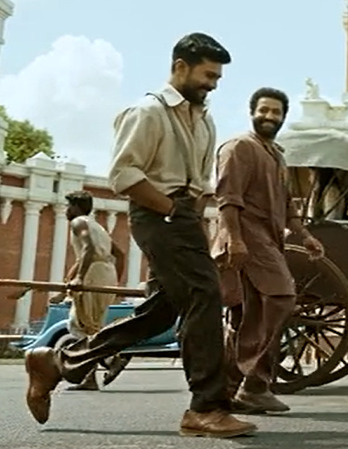
[ID: Ram and Bheem walking side by side. They are both laughing, and Ram is looking slightly down. His hands are in his pockets, but the wristband is still fully visible. End ID]
So, I think the framing matters here. If the flogging scene was drawing attention to the absence of the pendant on Ram's right wrist, these other shots are drawing attention to its presence. The more of the real Ram we see, the more of the pendant we see, again directly making the link that the wristband = Ram's humanity and true self.
Interestingly enough, it is only after he has officially saved Bheem that we get a clear closeup meant to show only the pendant again:

[ID: Ram lying on the grass after saving Bheem. He is out of focus, and his hand is extended towards the viewer. The pendant is falling over his palm, plainly visible and in focus. End ID]
If denying Bheem was denying his humanity, saving Bheem was saving it; it is back into focus, plainly visible and no longer locked away. I also find it interesting that this is when we finally get the flashback of when he gave the pendant to Seetha in the first place. At this point there's been 2h15m worth of movie and despite the fact that the pendant is very clearly referenced several times, we only get to see that moment right then. I think this implies that this is the moment when he finally connects with the part of him that's missing; it also drives extra attention to the relationship between saving Bheem and recovering that part of himself.
Not only that, but this is the first time we get a flashback that shows Ram driven by purpose, and not grief.
Ram has several flashbacks throughout the movie, but they are always of his father's death. His grief is the only thing pushing him forward. It is his grief that leads to him betraying Bheem (and I find it interesting that the pendant is also not visible in that scene, despite the fact that we get closeups of Ram's bloody right hand. I had kind of been assuming that they would show the pendant then, since it seemed to be connected to his purpose, but they don't. Now, I think that's exactly the point. The pendant is Ram's purpose, and he doesn't really have it in sight right then. He remembers the pain and the blood; he doesn't remember the ideals and hope that he had when he chose that path. He doesn't remember that this is about freedom, he only remembers that this is about a promise). It is his grief that he is thinking of when he's practicing shooting; whenever we see Ram's past, it is always focused on that one day.
The scene where he gives the pendant to Seetha is the first time we see a flashback with adult Ram. And in it we get to see Ram being tender (although he's still very serious); we get to see him talking about courage; we hear the "Vande Mataram" chant, a scream of love for the motherland rather than trauma and resentment; we get to see Ram being larger than life, motivated, focused. I mean, hell, Seetha puts a tilaka on his forehead. That is supposed to help one's focus, health, and mental stability, yes; but it's also related to the search for self awareness. Ram leaves with Seetha his humanity, and Seetha says goodbye by trying to connect Ram deeper with himself. Obviously, that doesn't last. But once again, the link that his connection with Seetha and the pendant = his connection to himself is strengthened.
And so, reliving that memory means finding that connection to himself again. It means finding his drive, his courage, his motive. It seems that, finally, Ram has remembered himself. And he achieved it through his love for Bheem, who, just like Seetha, now embodies his ability to connect to others, fight for what's right, and be himself.
I believe that this is also why, after that scene, the pendant stops being a wristband and becomes a necklace.
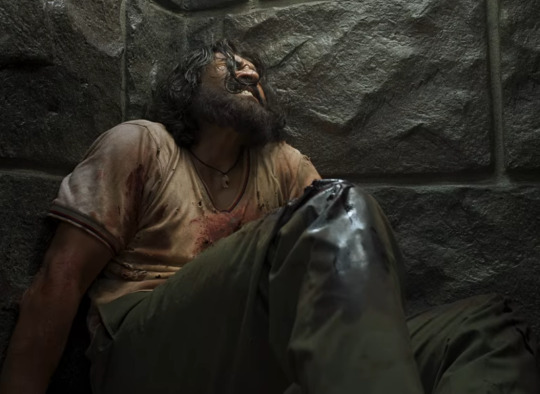
[ID: Ram in prison, groaning and throwing his head back. Due to the movement, you can see the pendant is now on a necklace. End ID]
A wristband is easier to see; it is something that you can always bring back to your line of sight. Wearing the pendant on a wristband, Ram is keeping it as a reminder; he is trying to make sure he doesn't forget who he is and what he's fighting for. We even see it serve that exact purpose during the torture scene with Lacchu. But a necklace doesn't need to be seen. Putting the pendant on a necklace means keeping it closer to his heart. At this point, Ram has internalized the pendant, and doesn't need to look at it to remember who he is; it's already a part of him. Because once he remembered who and what he's fighting for, and found again his humanity and drive, he didn't need it as a reminder anymore.
It's also worth noting that Seetha wears her own pendant as a necklace as well; when Ram puts it on the same place, it implies that their connection is stronger. As if they are no longer displaced and there is no longer the chasm between the Ram Seetha remembers and the Ram Ram sees.
Additionally, the pendant was originally a necklace before Ram broke it and gave it to Seetha:

[ID: Ram talking to Seetha before he leaves the village. He is wearing the pendant, which at this point is a full circle, as a necklace. End ID]
Then, immediately after he tears it, it becomes a wristband:

[ID: Ram spreading his arms as he gets on the boat that will leave his village. This is after he has broken the pendant, and he is no longer wearing it as a necklace; instead, we can see that he is wearing a wristband. End ID]
So, it being a necklace again also implies that he is going back to his roots, reconnecting to who he was and what he wanted when he first went on this mission.
Which is why it's extremely interesting that Bheem is the one to give Ram back the other half of the pendant. You'd expect it to be Seetha when they are reunited, but instead, Bheem takes it to him before he brings Ram back to Seetha. Which in turn reminds me of what he tells Seetha before going to rescue Ram:
"I will bring you back your Ram even if I have to lay down my life."
Again, I am going with the English translation, and I don't know what they say in the original, but I did once again check the Netflix translation and the translations in other languages that I speak/understand and they all kept the "your", except for Italian, so I am going to assume that this translation is accurate and close to the original Telugu.
This wording striked me as odd when I first watched, because why is Bheem emphasizing that Ram is Seetha's in that moment? Obviously they are engaged, so, you know, makes sense, but why is he emphasizing it? Rewatching it now, I think I get what he means: it's not just that he will bring back Ram; it's that he will bring back the Ram that Seetha knows. The real Ram. It's not enough to bring back Alluri Sitarama Raju; he is telling her that he will bring her the Ram she knows and loves, the one who's a rebel and who's whole. Which is why it makes sense that he takes Seetha's half of the pendant with him.
That is another part that first striked me as odd, because it seemed to directly contradict another thing he told her:
"Seetha shouldn't go looking for Ram. Ram should come to wherever Seetha is."
So why bring the pendant with him before reuniting Seetha and Ram? If this was simply about bringing Seetha and Ram back together, it would make no sense for Bheem to do this. Which is why I think that it's more than that; when he brings Ram back the pendant, when he puts the two halves back together with his own hands, he is making Ram whole again. Not just because he is saving him from death, but also because he is offering Ram his forgiveness and friendship again; and Ram needed that in order to move on from what he did, and find the person that he tried to bury and nearly forgot about these last 4 years.
In other words, the union of the two parts of the pendant is less about reuniting Ram and Seetha as people, and more about reuniting Ram with what Seetha represents; which, in turn, allows him to come back to Seetha as the Ram that she knew and missed.
(Of course, Ram will never go back to being exactly the same, and the pendant will always have the marks of the break; but it's rebuilding itself, and that's what matters)
And that is a natural conclusion to their relationship, because Bheem had been helping Ram find himself since the moment they met, as shown in the Dosti montage and the jarring differences between how Ram was and acted away from Bheem versus near Bheem. Not to mention Naatu Naatu, the first and only moment where Ram didn't just stand by and watch as his people were done injustice before he decided to save Bheem. The Ram that Seetha knew would never have come back to her if Bheem hadn't been there to help him find his humanity again. Which is why Bheem is the one to put the pendant together, and also why he is the one to put Ram's hand in Seetha's when they reunite; because without Bheem, Ram wouldn't have found his way back to her, because he wouldn't have found himself again.
I also think this is one of the reasons Bheem also puts a tilaka on Ram's forehead; of course, there is the fact that he is giving Ram the getup that he is known for, but remembering how Seetha had once put a tilaka on Ram's forehead, I think the fact that Bheem does it the second time also reinforces the connection between his relationship with Bheem and his relationship with Seetha, as well as the idea that he is reconnecting Ram with himself, just like Seetha tried to do when they were first parted.
Bringing Ram and Seetha together meant reconnecting Ram with his true self, and because Bheem was the one who reminded him who he was and what he was fighting for, he needed to be the one to do it.
#rrr#rrr 2022#alluri sitarama raju#komaram bheem#rise roar revolt#bheem#raju rrr#rambheem#ramseetha#meta#rrr meta
61 notes
·
View notes
Text


29 notes
·
View notes
Text
=Masterpost=

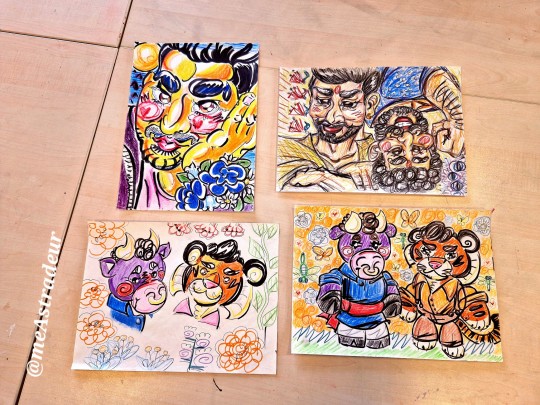

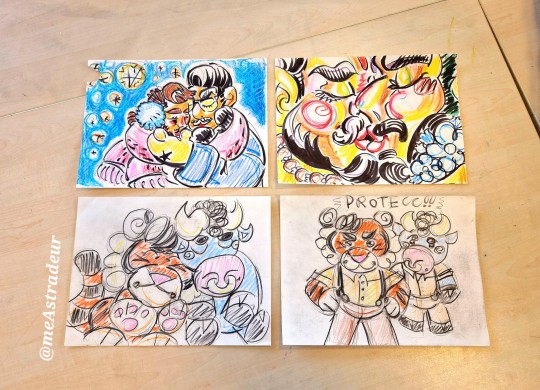
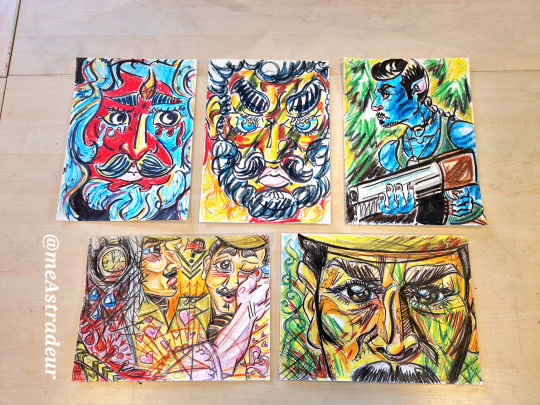
My RRR exhibition!!!🥳🥳🥳✨️✨️✨️✨️✨️
Thank you, to everybody who inspired me with your amazing stories!! This couldn't have become a reality without you guys showing me all the small details and all the beautiful nuances of these characters. Maan this has ben a long journey for this tiger!!🥹🥹🥰🥰🥰❤️🔥❤️❤️💫💫💫✨️🐯💫✨️💫✨️✨️✨️✨️✨️
@ronaldofandom @kaagazkefool @fangirlshrewt97 @ladydarkey @stanleykubricks @ssabriel @teddybat24 @burningsheepcrown @milla984 @minusculetony @carminavulcana @rambheemlove @ramcharantitties @jjwolfesworld @beingmes-blog @ronika-writes-stuff @umbrulla @yehsahihai @badtabbywhitecat @gifseafins @stuckyandlarrystuff @ramcharantitties @mesimpleone @boochhaan
#rrr#rambheem#ram charan#jr ntr#charak#komaram bheem#alluri sitarama raju#my art#rrr fandom#rrr fanart#my art 2022
64 notes
·
View notes
Text


I LOVE THEIR LITTLE DATES SO MUCH. Bros know each other for like, what, a day? and then proceed to hang out so casually that they're practically inseparable.
Bheem's (fake) family knows about Ram. Ram's uncle knows about Bheem's massive appetize.
They're infatuated with one another and they get to let go of their quests/responsibilities when they're with each other enough that it's heartbreaking when we see the plot unfolds. Just. Mwah. Chef kisses for the writing of this movie.
143 notes
·
View notes
Text
Fandom : RRR (2022)
Title : My Hero
Characters : Ram & Bheem
Summary : a poem from Ram’s POV about Bheem

#rrr#rrr movie#rrr fandom#rrr 2022#tollywood#rrr fanfic#rrr fanfiction#ram rrr#rrr bheem#poetry#rrr poem
14 notes
·
View notes
Photo


Thank you @fangirlshrewt97 for the request! [insp.]
@rambheemlove, @dumdaradumdaradum, @budugu, @burningsheepcrown, @iam-siriuslysher-lokid, @stanleykubricks, @ssabriel, @ronnoxandlumoss, @bitchy-bi-trash, @voidsteffy, @nyotamalfoy, @thewinchestergirl1208, @jrntrtitties, @ronaldofandom, @boochhaan, @lite-teesko, @stuckyandlarrystuff, @bromance-minus-the-b, @ladydarkey, @carminavulcana, @kaagazkefool, @vidhurvrika, @jjwolfesworld
»»»— read pinned post for taglist info —«««
»— Masterlists links in bio —«
#rrr 2022#rrr movie#rambheem#rambheem gifs#my gifs#rrr bheem#rrr ram#rrr bheem gifs#rrr ram gifs#but also babai and sita#rrr komaram bheem#rrr ramaraju#rrr ramaraju and bheem#milla gifs rrr
89 notes
·
View notes
Note
love hiiii !!!

#rrr fanfic#jr ntr#rambheem#rrr fandom#alluri sitarama raju#jadeja#rrr 2022#ravindrajadeja#ram x bheem#naatu naatu
9 notes
·
View notes